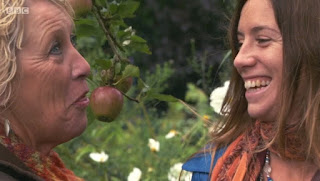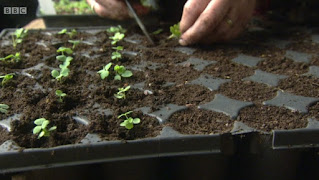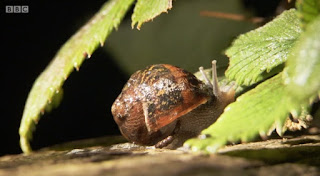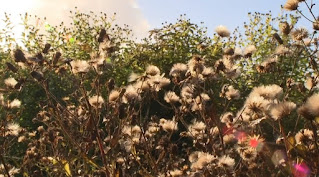
Carol Klein welcomes us to Life in a Cottage Garden at her home Glebe Cottage, Chittlehamholt near Umberleigh Devon, 15 miles from the coast.
For over 30 years Carol has looked after the garden which is loved not only by herself but her family too and she knows every part of the soil and the plants.
She loves spending time in the garden and enjoying the peace of the surrounding countryside.
Every season brings delight, challenges and problems 'but that's the thing about gardening, it's ever-changing and its's always exhilarating.
Over the 6 episodes Carol is going to show a whole year in the garden 'how it grows, flourishes, dies and is reborn.
In September and October the garden reaches its Autumn peak with the smell of ripening fruit and colour everywhere from brilliant yellow, blues from Michaelmas Daises, vibrant Canna and Dahlias.

Autumn is not just a corridor between Summer and Winter but a season of its own and you have to be out collecting seeds, the digging begins the air is filled with the smells of bonfires and decay.

They have 2 daughters Annie and Alice and they each have their own garden and Carol loves it when they come and visit.
Carol big project this year was to completely redo Annie's garden and Annie is in the garden to help decide what to do about the diseased Apple Tree.

It has Canker and lots of dead bits although in the Spring it was full of blossom and now full of fruit.
Annie says its been there as long as she can remember and as it is diseased and may spread it, it may be time to say goodbye to the tree.
It will be sad she says as it is a big part of the garden 'all good things come to an end'.

'Really? that's very philosophical of you' says a surprised mum who very shocked as she thought the tree wouldn't be allowed to be touched.
Maybe juicing the apples to remember it by suggests Annie.
It is raining so Carol heads for her potting shed and she says you always want September to have an 'Indian Summer' but today it is windy and pouring with rain.

This gives her a chance to catch up in the potting shed and she has some Aquilegias she sowed a few weeks ago and because they flower early you can collect the seeds early and get them sowed.
These now are ready for pricking out which means by the Winter they will be a decent sized plant.
They will be ready to go out next Spring.

Carol finds these sort of jobs very restful and gives her a chance to think about the wonderful life cycle of the plants in the garden.
She pots them on in individual sections in a seed tray, covers with grit and leaves them outside for the rain to water them.
Carol is in the Hot Border that has been at its peak for the last few weeks, staking up plants that are drooping.
The Rudbeckia usually stands up on its own but its been pushed forward by the other plants, so staking will help.

There also some dead leaves to clear up from a Canna that have been mauled , some of the leaves are still pristine but the slugs and snails have been at the bottom leaves.
There is also the deadheading to keep on top of to encourage new flowers and they need cutting back to the next leaf axil, scissors will do if you have no secateurs.

When deadheading Dahlias the flower buds feel different as they are round and solid but the dead buds are squidgy and soft.
It used to be that Allotments were the only place you would see Dahlias as people would grow them to show.

Now they are accepted into 'polite garden society' and they are a dazzling plant that comes from Mexico.
If you got a Dahlia and want lots more, you need to bring them forward into growth in March somewhere warm, water and feed them to get robust shoots.
You then with a sharp knife cut off the shoot right by the tuber and pull it away.

Then you place it in a clay pot with gritty compost, you them water them well and feed them in a warm place you should get a new plant grow.
You then pot it on to a bigger pot, cover with grit as usual and grow them on although Carol recommends not putting them out in the garden the first year but to over Winter them so they make tubers so they will be more likely to survive.
Autumn, the time for garden bounty and Carol is picking bean pods and sweetcorn and hanging her onions to dry out.

Carol is out after dark with her torch searching for snails and slugs with a bucket full of water to put them in.
Tomorrow she is opening her garden for the National Garden Scheme which she thoroughly enjoys doing so she wants the garden to look its best.

She really enjoys talking to the visitors and getting ideas and sharing tips and encouraging everyone.
She worries what they are going to make of her Lobelia 'its completely mullered'!

It is the day of the National Garden Scheme open day and lots of people are arriving and buying their tickets.
The garden is filled with chatter and Carol is advising a visitor of what soil the Clematis likes, alkaline with lots of substance.
Visitors sit and admire the garden as Carol tells another visitor the grass she grows with Rudbeckias is a Molinia but not a huge arching one.

Carol surrounded by visitors shows off an Agaster thats great for butterflies, bees and insects.
She takes a flower and taps out the seeds into her hand for next years plants to show them how easy it is to collect.
After the tea and cakes and the plant sale have ended and all the visitors have left Carol is sitting having a drink with her dogs talking about what a lovely day it has been.

Carols says you get so used to being on your own in your garden and although she loves the solitary aspect of gardening to then have it open and full of visitors to share it with is so rewarding.
People observing things in the garden and making suggestions and saying all sorts of encouraging things and also loving her garden too, you know you are doing well in the garden.

October is a golden month with lots of changes, with the dark mornings and cold nights but in the day it can be glorious as everything in the garden is dying down.
The Brick Garden is between the Hot Beds and the Top Terrace and is the hub of the garden and changes most in the garden throughout the year.
It is like a calendar and you can see the different seasons and in the Autumn it looks amazing with the 4 big clumps of Hakonechloa making a statement.

It swishes and moves in the wind and in early Spring / late Winter it was chopped back right to ground level.
Carol's Euphorbia Palustris she loves at this time of year when as its dying it goes an golden amber unlike the vivid green it is in Spring.
It makes a good companion plant to her Rudbeckia and the whole garden is packed with North American Daisies.

Rudbeckia is the most dominant one for its bright yellow flowers but as they start to fade they leave the black come in the middle that Carol leaves right through the Winter.
It is covered with butterflies followed by birds after the seeds.

The once blue Aster now has fuzzy seeds that will fly away and disappear leaving behind the empty silver star flower heads.

In May the bees and new hive arrived and have filled the garden with their hum.
Phil Chandler and Neil are checking out the bees before the cold of winter sets in.
He holds up a comb to show the finished honey which is there winter store and they need 35 - 40 pounds of honey stored to see them through.
They are not sure they have enough to last so are giving them some additional food using a plastic bucket with a clip on lid as a feeder.

Inside the bucket is 2 litres of sugar syrup and the lid is perforated which he demonstrates by holding it upside down and after the initial overflow runs out he places it upside down on the hive for them to come and feed from.
Neil now feels very optimistic for the Winter and the bees survival and Carol thanks Phil.
Collecting Seeds
As soon as a flower comes out Carol is already thinking about them setting seed for her to collect.
It is a perfect sunny and warm day for it and she had already noted her 2 Eryngiums that they were both very desirable, one was a deep purple and the other a sparkling blue so she has taken photos.

She wants to collect the seeds separately to sow apart and she has already tied markers round the best seed heads.
She snips them off the prickly plant and puts the seed heads in a paper bag.
Next she is collecting from a Scabious and it used to be called Scabiosa Ochroleuca but it has changed its name to Cephalaria Ochroleuca.

It has very pale lemon flowers that insects love but the seed heads are also very attractive and the seeds fly away.
Next its off to the Woodlands to collect a berries from the foliage plant Arum Italicum Pictum and it has beautiful leaves all Winter long and the berries are on a stem.

Inside each berry is 1-2 large seeds that she station sows right there in the wood.
She sows them in a seed tray until they grow on, next Spring she can prick them out and by Autumn next year they can be planted out.

Late October and Carol is raking leaves in the Woodland and taking them to her leaf mould pile.
The colours in the garden have been beautiful especially the Phylums which have been every colour from yellows, ambers and russets.
Carol's little shrub Fothergill has been the most amazing colours it has ever been this year.

But her favourite is Acer Osakazuki and she has a sentimental attachment as her Mother gave it to her.
It is just on the brink of turning into the most glorious scarlet colour.
September and October have been wonderous and they did have the 'Indian Summer' and the garden is glowing but every day there is less leaves on the trees.

The northly wind has started to blow and it is time for warmer clothes and Winter is coming.
All photographs are copyright of BBC.com

No comments:
Post a Comment